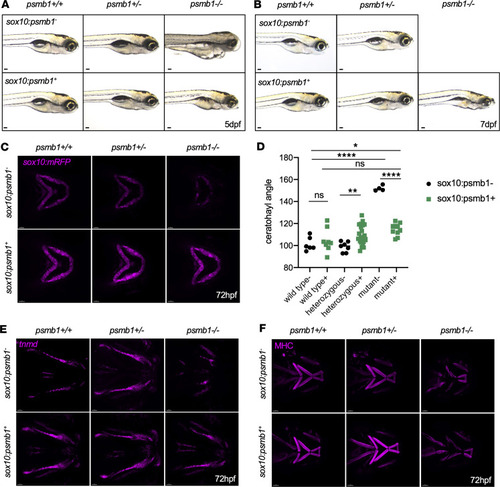|
Overexpression of psmb1 in the neural crest and chondrocytes rescues mutant cartilage and tendon phenotype. (A) Bright-field images of psmb1 wild-type, heterozygous, and mutant larvae with and without sox10:psmb1-2A-GFP transgene at 120 hpf. Scale bars: 100 μm. (B) Bright-field images of psmb1 wild-type, heterozygous, and mutant larvae with and without sox10:psmb1-2A-GFP transgene at 7 dpf. Scale bars: 100 μm. (C) Confocal imaging of sox10:mRFP, psmb1 wild-type, heterozygous, and mutant larvae with and without sox10:psmb1-2A-GFP transgene at 72 hpf. Scale bars: 50 μm. (D) Quantification of ceratohyal angle in images from C demonstrates that ceratohyal angle is almost completely restored in rescued psmb1 mutants. Data shown represent mean ± SD. n = 6, 8, 7, 22, 4, 10. Significance was calculated with 2-way ANOVA. *P < 0.05, **P < 0.01, ****P < 0.0001; ns, not significant. (E) sox10:psmb1-2A-GFP transgene substantially improves tendon phenotype, as assessed by RNAscope for tnmd at 72 hpf. Scale bars: 50 μm. (F) sox10:psmb1-2A-GFP partially rescues muscle phenotype, as assessed by antibody staining for myosin heavy chain (MHC) at 72 hpf. Scale bars: 50 μm.
|

